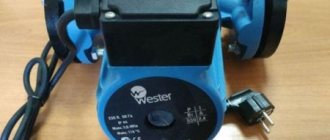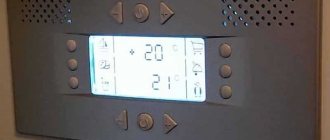Despite the widespread use of heating systems with natural coolant circulation, they have a number of serious disadvantages. These include the low speed of fluid movement, which negatively affects the final temperature in the return circuit. It should also be mentioned that not all radiators receive the same amount of hot water. Such shortcomings do not allow the house to be provided with sufficient heat.
However, today this problem can be solved if the heating system operates in combination with a circulation pump . Here the problem arises: which one to choose? If you turn to specialists, then, in their opinion, the best option among all the options offered is the Grundfos UPS pump.
Installing a heating pump: how to properly install pumping equipment
The circulation pump increases the efficiency of the autonomous heating system and allows 100% use of all heating circuits.
Professional installation of a heating pump guarantees high performance, reduces operating noise and reduces maintenance and repair costs. Installing the device does not cause any particular difficulties, but there are a number of nuances that are important to consider.
We will tell you how to choose a circulation pump, help you decide on the optimal scheme for inserting equipment into the system, outline installation requirements, and also provide step-by-step instructions for installing the device.
Popular models and features of Grundfos pumps
There are more than 30 Grundfos well models. They have protection against power surges, dry running, and are equipped with a soft start device and pressure sensors. The mechanisms automatically regulate the shaft speed and respond in time to engine overheating. Selecting the right pump brand is easy. You just need to know the depth of the well and the required volume of water consumption at home.
The most common are the units of the SQ, CR, SPO series, as well as the new line of submersible mechanisms Sba and Sb. Basic SB models are affordable domestic well installations. The difference between SBA is that this equipment is equipped with an additional control unit.
SQ Series Well Pump
The single-speed SQ pump is well suited for wells with automation. The range of three-inch borehole rigs has a wide range of positive characteristics. All devices are made from high-tech stainless steel and composite materials.
The pump is driven by alternating current from the public power supply. The mechanism is equipped with a built-in frequency converter, which allows you to maintain constant pressure in the system.
Technical features:
- power 1.15 kW;
- productivity 3 m³/h;
- immersion depth 30 m;
- pressure force 89 m;
- dry running protection;
- high efficiency of the electric motor;
- wear resistance;
- “soft start” system;
- increased housing tightness;
- protection against power surges.
Features of the KR series
Well pump Grundfos CR.
The CR pump is a multi-stage vertical installation with normal suction. The unit body is made of cast iron, titanium or stainless steel. The devices are equipped with electric motors with adjustable rotation speed with a power of 0.25-3.0 kW (220 V).
The cylindrical casing and intermediate chambers are connected to the base using long coupling bolts (in-line diagram).
This design of the equipment allows its installation on both vertical and horizontal pipelines. KR series pumps are designed for pumping and increasing the pressure of hot and cold liquids without fibrous and solid inclusions.
The generated pressure force is 270 m. Productivity is 180 m³/h.
The operating principle of CR pumps is based on increasing the pressure of water moving from the inlet to the outlet. The working shaft of the unit is equipped with spiral-shaped metal blades. Liquid from the suction line enters the pump impeller and is thrown towards the walls of the casing. After this, water under high pressure enters the pressure line.
All equipment in this model range is equipped with a mechanical shaft seal and does not require maintenance.
Features of using Grundfos spо
The Grundfos SPO five-inch submersible well pump is used for domestic water supply systems. Used for pumping clean liquids from underground sources and storage tanks.
The pump housing is made of corrosion-resistant materials. All samples are supplied with a single-phase electric motor. The drive is installed at the top of the installation. The pumped liquid passes between the device housing and the electric motor casing, providing effective cooling to the installed equipment.
Specifications:
- productivity - 6.5 m³/h;
- pressure force - 75 m;
- liquid temperature - up to 40°C;
- case diameter - 140 mm;
- weight - 15-20 kg;
- immersion depth - 20 m.
Grundfos pumps of this model can be produced in 2 versions: with a base support and a filter grid.
SPO units are designed to lift only clean water. They are not used for pumping liquids with fibrous and solid abrasive inclusions. To protect equipment from premature wear, strainers are installed on the suction pipes of the units. The grilles can be easily removed from the device body for maintenance and repair.
Pumps with a base support are universal devices. They can be installed on the bottom of the pool (underwater) or placed next to the storage tank.
Purpose of the pump for heating
Previously, circulation pumps were used only in centralized heating systems, and for private housing construction the natural movement of the coolant caused by temperature differences was the norm.
Now forced circulation is used everywhere thanks to the emergence of compact and inexpensive models designed to service the heating networks of small houses and cottages.
Due to the increase in the speed of movement of the coolant in the pipeline, thermal energy flows faster to the heating radiators, and accordingly, the rooms are warmed up faster. The load on the boiler has decreased because the water is also heated faster.
The need to install bulky and inconvenient large-diameter pipelines has disappeared; contours have become easier to camouflage under floor coverings or be buried in walls.
The main disadvantage of pumps for heating systems is their dependence on electricity. If the power supply is intermittent or there is a risk of a complete power outage for some period, it is necessary to install a backup power generator or at least an uninterruptible power supply.
The remaining disadvantages relate to the designs and functionality of various types of devices. For example, monoblock units and devices with a dry rotor are noisier and require constant maintenance, while a pump with a wet rotor is demanding on the quality of the coolant and has a pressure limitation.
Installation rules
There are several simple rules for installing a circulation pump, compliance with which will ensure high-quality operation of the mechanism. Particular attention should be paid to the horizontal position of the shaft in the pipeline. If it is installed at an angle, performance may decrease by a third.
The Grundfos heating circulation pump can be installed in an existing heating system that previously used natural circulation.
In this case, you need to pay attention to the piping of the device and provide a bypass line. It is recommended to install valves on both sides of the device. This will allow the pump to be removed in the event of a breakdown without draining the liquid from the pipeline.

Correct installation option
Most often, pumps for the heating system are installed in the return circuit, this is due to a number of reasons:
- high water temperatures lead to rapid wear of individual parts;
- if the pump is installed immediately after the boiler, then its operation can lead to a lack of liquid in the generator and cause the coolant to boil;
- Air often accumulates in the upper part of the pipeline, which reduces the speed of operation of the device and reduces the efficiency of all heating equipment.
Criteria for proper selection of equipment
All installation efforts will be reduced to zero if the equipment is selected incorrectly. In order not to make a mistake, it is necessary to first analyze all aspects of a particular heating system and make the necessary calculations.
Main types of pumps
According to their design features, all devices are divided into 2 categories: with a wet and dry rotor.
Wet type pumps . This option is suitable for private homes. The unit is compact, almost silent and has a modular structure that is convenient for maintenance and repair.
But, unfortunately, it does not have high productivity - the maximum efficiency of modern models reaches 52-54%.
Pumps with a dry rotor are productive, unpretentious to the quality of the coolant, capable of operating under high pressure and do not require a strictly horizontal position on the pipe. However, they are noisier, and their operation is accompanied by vibration. Many models are installed on a foundation or metal support frame.
For installation of console, monoblock or “In-line” models, a separate room is required - a boiler room. It is advisable to use them when a flow rate of more than 100 m³/h is required, that is, for servicing groups of cottages or apartment buildings.
Brief overview of technical characteristics
When choosing a pump, you should definitely study the technical characteristics and compare them with the requirements of the heating system.
The following indicators are important:
Structural details are also important, for example, the inlet/outlet diameter of the pipes. For heating systems, the average parameters are 25 mm and 32 mm.
An example of a unit for equipping a residential heating network with an area of 100 m² is a Grundfos UPS with a 32 mm pipe connection, a capacity of 62 l/s and a weight of 3.65 kg. The compact and low-noise cast iron device is inaudible even behind a thin partition, and its power is sufficient to transport liquid to the 2nd floor.
Pumps with built-in electronics allow you to quickly switch equipment to a more convenient mode depending on changes in temperature or pressure in the network. Automatic devices are equipped with digital displays that provide maximum information on the operation of the pump: temperature, resistance, pressure, etc.
Additional information on the calculation and selection of a circulation pump for heating is presented in the articles:
Technical characteristics overview
You can get an idea of the technical characteristics of the device using the example of one of the manufacturer’s models, which can be the Grundfos UPS 25-40ST pump . This device is in fairly high demand among owners of country houses.
If you analyze the numbers present in the marking, you can understand that the model is equipped with pipes with a diameter of 25 mm, having a pressure of 4 m. This product is capable of ensuring the efficient operation of the heating systems of a one-story house.
If the heating is presented in the form of a single-pipe system, then such a Grundfos circulation pump can successfully perform its functions in a two-story house.
Requirements for installation of a circulation pump
There are a number of standards that regulate at the legislative level the installation of a circulation pump in a heating system. Some of the rules are set out in SNiP 2.04.05 “Heating...”. For example, it talks about the priority of schemes with forced circulation in heating networks.
Almost all requirements are justified by the operating efficiency of the system as a whole and the circulation device in particular. For example, the shaft of a device with a wet rotor must be installed on the pipe strictly horizontally in level so that there are no air pockets inside and the pump parts do not wear out prematurely.
A filter for dirt and abrasive particles is needed in any case, even when installing monolithic models. Filtered coolant will cause much less damage to pump parts than liquid with sand and suspended matter.
The mudguard is installed with the plug down in the direction of water movement to reduce resistance and facilitate system maintenance.
Some rules are dictated by manufacturers. For example, it was customary to install old models of certain brands exclusively on the return line, since they could not withstand high temperatures.
Analysis of installation technology
The installation process itself is quick; to secure the housing, you need to secure two union nuts. This is very convenient for further maintenance and repair work. But before installation, it is necessary to choose the right installation location, otherwise the pump will either work intermittently or will soon fail.
Schemes for inserting a pump into the network
When choosing one of the schemes, it is necessary to take into account the type of heating system, boiler model and ease of maintenance.
Option 1. This is the most common solution: the pump is mounted on the “return”, through which the cooled coolant returns to the boiler. Warm water does not have such an aggressive effect on the parts of the device, so it lasts longer.
Option 2 . This solution is relevant if for some reason it is not possible to install a pump on the return line. Then it is fixed at the beginning of the circuit, at the supply, but not near the boiler, but after the safety group.
Modern devices can easily withstand high temperatures, but there are still experts who reject such a scheme.
There is such a heating network option as an open system with an expansion tank installed at the highest point of the circuit.
If you install a circulation pump, you will be able to operate it in two modes: natural and forced. Natural circulation will come in handy if there are power outages.
The last scheme applies only to networks with a solid fuel boiler. The supply pump is not installed due to the risk of explosion. The fact is that with solid fuel boilers it is impossible to quickly stop the heating process, as a result of which the water boils.
If you run cooled water from the circuit into a heating boiler, condensation will form. To prevent this from happening, the water is first heated in the small circuit to +55°C, and then the thermostatic valve smoothly switches to the large circuit.
As a result, cold water is mixed with already heated water and “temperature shock” does not occur for the boiler.
How piping is done
The circulation pump piping is the equipment necessary for its proper functioning, as well as for the smooth operation of the entire heating system.
First you need to finally decide how many pumps there will be. For one simple circuit, one device is enough, but with complex wiring it is possible to install two or more.
If you plan to use a “warm floor” system in your house or install an indirect heating boiler, then it is better to increase the number of appliances to two. If two boilers are installed - solid fuel and electric - you will also need a separate pump for each unit.
As mentioned above, ball valves are mandatory elements. They are mounted together with the pump, and in the event of an emergency, they will have to be used.
A check valve made of brass or cast iron is also required so that the coolant moves in one given direction. It is mounted on the pipe immediately after the pump, in the direction of water movement.
A “dirt filter” will be required to prevent solid particles from entering the device housing. Fine filters are not installed in heating circuits. If clean water is needed, it is pre-purified before being poured into the system.
There is a risk of air getting into the network, so there is a need to install an air valve. It can turn on automatically, but there are also manual models.
After installing all the devices, the pump is connected to power. A big mistake is to use an ordinary outlet without grounding. This is a safety violation and can cost lives in the event of an accident.
There are smarter ways to power power:
The easiest way is to use a circuit breaker: you will need an 8 A switch itself, contacts, and wires. But for practical use, a solution with a thermostat is very convenient.
If you plan to install a UPS, you can connect an uninterruptible power supply to both the pump and the boiler at the same time.
Types and advantages of well pumps
The Grundfos concern (Denmark) produces pumping equipment for domestic and industrial water supply systems. Pumps from this company are widely used in various areas of management - in summer cottages for watering crops, increasing the pressure in supply pipelines, to create effective fire extinguishing systems in public and industrial buildings.
Main groups of manufactured equipment:
- submersible systems (SP);
- circulating (UP);
- centrifugal (CR).
A submersible well pump is capable of ensuring uninterrupted delivery of water to the house from underground sources with a depth of 8-300 m. Surface installations are designed to service wells up to 10 m.

Grubdfos well pump.
All Grundfos pumping equipment is equipped with monitoring equipment , which allows automatic starting and stopping of pumping devices, as well as maintaining constant pressure in the water supply system.
Advantages:
- favorable price-quality ratio;
- ease of maintenance;
- high energy efficiency;
- maximum equipment efficiency;
- durability;
- manufacturer technical support;
- increased hydraulic characteristics;
- The bearing design provides protection of parts from abrasive wear.
Brief installation instructions
A common option is to install the pump on a bypass. This is due to two good reasons: it becomes possible to quickly dismantle or temporarily disconnect the device from the network, for example, if problems arise with electricity.
Various modifications of ready-made pumping units are available for sale: for welding or flange connection, with places for installing taps or valves, with a special area reserved for the pump.
But if you cannot purchase a ready-made unit or there is not enough space for its installation, you can independently organize the bypass piping and fix all the parts in the places allocated for them.
The following tools and materials are required for work:
American nuts are usually supplied with the pump, but taps, adapters or fittings will also have to be prepared. Attention should be paid to more reliable materials for making fittings and the diameter of the products.
What is a circulation pump and why is it needed?
A circulation pump is a device that changes the speed of movement of a liquid medium without changing pressure. In heating systems it is installed for more efficient heating. In systems with forced circulation it is a mandatory element, in gravity systems it can be installed if it is necessary to increase the thermal power. Installing a circulation pump with several speeds makes it possible to change the amount of heat transferred depending on the outside temperature, thus maintaining a stable temperature in the room.

Cross-section of a circulation pump with a wet rotor
There are two types of such units - with a dry and wet rotor. Devices with a dry rotor have a high efficiency (about 80%), but are very noisy and require regular maintenance. Units with a wet rotor operate almost silently; with normal coolant quality, they can pump water without failure for more than 10 years. They have a lower efficiency (about 50%), but their characteristics are more than sufficient for heating any private home.
Design features
For the manufacture of certain parts of the grundfos pump, different materials can be used: cast iron is used for the pump body, aluminum is used for the motor.
The material used for the impeller and bearings is ceramics, and for the rotor of a solid design – steel. When choosing each of these materials, their characteristics were taken into account. Thanks to them, these elements demonstrate high strength and cope well with coolant heated to high temperatures. First of all, you should highlight the bearings. Even if the pump is used in particularly harsh conditions, ceramic bearings can operate without a single repair for up to 10 years. In addition, the use of ceramics provides the advantage of reducing noise during rotor rotation.
If we evaluate the manufacturer’s assortment, it includes models of grundfos circulation pumps equipped with a technopolymer impeller and a ceramic rotor. Through the use of such innovations, it is possible to significantly increase the efficiency of the installation and extend its operational life. These features should be remembered by those for whom it is important to install a high-quality device into the heating system.
Where to put
It is recommended to install a circulation pump after the boiler, before the first branch, but on the supply or return pipeline it doesn’t matter. Modern units are made from materials that can withstand temperatures up to 100-115°C. There are few heating systems that work with a hotter coolant, so considerations of a more “comfortable” temperature are untenable, but if you feel safer, put it in the return line.

Can be installed in the return or direct pipeline after/before the boiler up to the first branch
There is no difference in hydraulics - the boiler, and the rest of the system; it makes absolutely no difference whether there is a pump in the supply or return branch. What matters is the correct installation, in the sense of strapping, and the correct orientation of the rotor in space. Nothing else matters.
There is one important point regarding the installation location. If the heating system has two separate branches - on the right and left wings of the house or on the first and second floor - it makes sense to install a separate unit on each, and not one common one - directly after the boiler. Moreover, the same rule remains on these branches: immediately after the boiler, before the first branch in this heating circuit. This will make it possible to set the required thermal conditions in each part of the house independently of the other, and also in two-story houses to save on heating. How? Due to the fact that the second floor is usually much warmer than the first floor and much less heat is required there. If there are two pumps in the branch that goes up, the speed of movement of the coolant is set much lower, and this allows you to burn less fuel, without compromising the comfort of living.
Harness
There are two types of heating systems - forced and natural circulation. Systems with forced circulation cannot work without a pump; systems with natural circulation work, but in this mode they have lower heat transfer. However, less heat is still much better than no heat at all, so in areas where electricity is often cut off, the system is designed as hydraulic (with natural circulation), and then a pump is installed into it. This gives high heating efficiency and reliability. It is clear that the installation of a circulation pump in these systems is different.
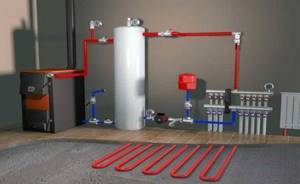
All heating systems with heated floors are forced - without a pump, the coolant will not pass through such large circuits
Forced circulation
Since a forced circulation heating system without a pump is inoperative, it is installed directly into the gap in the supply or return pipe (of your choice).
Most problems with the circulation pump arise due to the presence of mechanical impurities (sand, other abrasive particles) in the coolant. They can jam the impeller and stop the motor. Therefore, a mesh dirt filter must be placed in front of the unit.
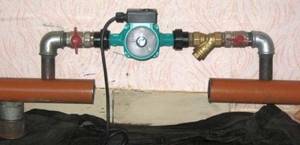
Installing a circulation pump in a forced circulation system
It is also advisable to install ball valves on both sides. They will make it possible to replace or repair the device without draining the coolant from the system. Turn off the taps and remove the unit. Only that part of the water that was directly in this piece of the system is drained.
Natural circulation
The piping of the circulation pump in gravity systems has one significant difference - a bypass is required. This is a jumper that makes the system operational when the pump is not working. One ball shut-off valve is installed on the bypass, which is closed the entire time the pumping is running. In this mode, the system operates as forced.
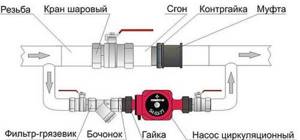
Installation diagram of a circulation pump in a system with natural circulation
When the electricity goes out or the unit fails, the valve on the jumper is opened, the valve leading to the pump is closed, and the system operates as a gravity system.
Installation features
There is one important point, without which the installation of the circulation pump will require rework: it is necessary to rotate the rotor so that it is directed horizontally. The second point is the direction of flow. There is an arrow on the body indicating which direction the coolant should flow. This is how you turn the unit so that the direction of movement of the coolant is “in the direction of the arrow”.
The pump itself can be installed both horizontally and vertically, just when selecting a model, make sure that it can work in both positions. And one more thing: with a vertical arrangement, the power (pressure created) drops by about 30%. This must be taken into account when choosing a model.
What to pay attention to during installation?
A difficult point at the installation stage is the correct choice of the direction of the pipes.
However, there will be no problems with this due to the fact that the manufacturer has taken the necessary measures that will simplify the solution of this problem. If you look at the pump body, you can see an arrow corresponding to the rotation of the rotor. From it you can understand in which direction the coolant is moving. Please note that the circulation pump is sold without mounting hardware . Therefore, you will have to buy them separately. Having completed the installation of the circulation device, you should pause for a day, and then you can start the pump. This must be done for the reason that the operation of circulation pumping equipment must take place exclusively at positive indoor temperatures. If before purchasing the pump it was located or transported in the cold, then without natural heating of its component elements during startup there is a risk of its breakdown.
To connect the device to the AC network, it is advisable to use a separate cable separated from the distribution panel. If you use the Grundfos UPS 25-40 model, you can choose a three-core copper cable with a cross-section of one core of 0.75 mm2.

